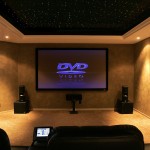 With the right equipment in the right place, all you need is the popcorn to complete the full movie-going experience at home.
With the right equipment in the right place, all you need is the popcorn to complete the full movie-going experience at home.
One question we get asked often is which is better, a 5.1 or 7.1 channel home theatre receiver.In turns out that both options have advantages and disadvantages, depending on what source components you are using and what your personal preferences are.
5.1 Channel Home Theatre Receiver Overview
5.1 channel home theatre receivers have been the standard for two decades. They provide a perfectly good listening experience, especially in small to average-sized rooms. A 5.1 channel system consists of:
1. A Centre Channel to provide an anchor stage for dialogue or music vocal.
2. Left and Right Front channels to provide the main soundtrack information, or for stereo music reproduction.
3. Left and Right surround channels for side and front to rear motion effects from movie soundtracks and ambient sounds from music recordings.
4. The Subwoofer channel, which provides the extreme low frequency effects, such as explosions or bass response in music performances.
7.1 Channel Home Theatre Receiver Overview
However, when trying to decide if a 5.1 or 7.1 channel home theatre receiver is right for you, there are several practical features of a 7.1 channel receiver that could be of benefit that you may not have considered.
1. A 7.1 channel system incorporates all the elements of a 5.1 channel system, but instead of combining both surround and rear channel effects into two channels, a 7.1 system splits the surround and rear channel information into four channels. In other words, side sound effects and ambience are directed to left and right surround channels, and the rear sound effects and ambience are directed to two rear or back channels. In this set-up the surround speakers are set to the side of the listening position and the rear or back channels are placed behind the listener.
2.The 7.1 channel listening environment can add more depth the surround sound experience, provide more a specific, directed, and immersive soundfield, especially for larger rooms.
3. Although most Blu-ray soundtracks are 5.1, there are an increasing amount of Blu-ray soundtracks that contain 7.1 channel information – whether it be 7.1 channel uncompressed PCM, Dolby TrueHD, or DTS-HD Master Audio.
4. Also, even with playback of standard DVDs, if your DVD soundtrack only contains Dolby Digital or DTS 5.1 by using the extension or other available 7.1 DSP surround modes that may be available on your receiver, you can still extract a 7.1 channel surround field from both 2 or 5.1 channel source material.
5. In addition, if you prefer 5.1 channels for your main room, most 7.1 channel receivers have the ability to use the extra two channels to provide a 2-channel speaker operation in a second location. What this means is that, in many cases, while you are listening and watching your DVDs in 5.1 channel surround sound in your main room, someone else could be listening to a CD (provided you have a separate CD player connected to your receiver) in another room, without having a separate CD player and receiver in the other room – just the speakers.
9.1 Channels and Beyond – Large Home Theatre Rooms / Cinema Room
A good 5.1 channel receiver is a perfectly fine option, especially for a small or average room in most apartments and homes.
However, once you get into the $500 range and up, there is an increasing emphasis by manufacturers with 7.1 channel equipped receivers. Additionally, when you get into the $1,300 an up price range you start seeing some 9.1 channel receivers. These receivers can provide very flexible set-up options as you expand your system’s needs, or have a large home theatre room.